Art History Egyptian Art + Near Eastern Art
1/17
There's no tags or description
Looks like no tags are added yet.
Name | Mastery | Learn | Test | Matching | Spaced |
|---|
No study sessions yet.
18 Terms

Image 12: WHITE TEMPLE AND ZIGGURAT
FORM:
Ziggurat → (in ancient Mesopotamia) a rectangular stepped tower, sometimes surmounted by a temple = PLATFORM
Height → 40 FT. tall
Medium → White-washed sand to disguise average mud brick appearance
FUNCTION:
Dedicated to gods
Anu → Sky god; most important Sumerian god
Elevated from ground– signify gods are more important than people
Bent axis plan → no straight pathway to protect sacred place (temple)
Place of worship
Corners are situated according to compass points
CONTENT:
Corners of ziggurat → points of the compass
Set high above ground → when Sumerian gods came to earth, they descended to high places
Exterior → White washed sand, stepped pyramid leading to a higher temple at the top
Temple → sits at the top of the ziggurat
Interior → Inside the temple houses the cella
Cella → Main room of a temple where a god is housed
CONTEXT:
Location in City → CENTER OF THE CITY
Metaphor that the gods are the center of people’s lives
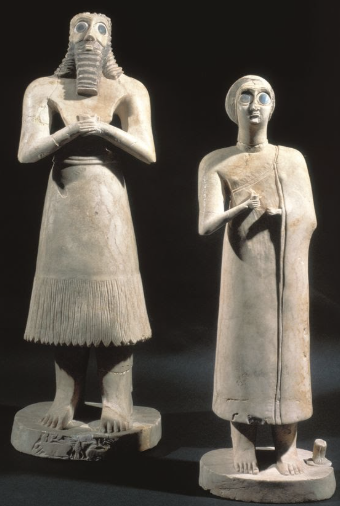
Image 14: STATUES OF VOTIVE FIGURES
FORM:
Medium → Gypsum inlaid with shell & black limestone
Gypsum → a soft white or gray mineral consisting of hydrated calcium sulfate
FUNCTION:
Used for prayer, offerings
Votive → “offered in fulfillment of a vow or a pledge”
Represents mortals, placed in temples during prayer time
CONTENT:
Figures → different heights
Hierarchy of scale
Hands → folded in prayer
HUGE EYES → CREEPY, spellbound, cast towards sky… maybe at some deity?
Men → bare upper chest;
Clothing → cone-like skirt, wears belt
Beard & hair → in simple, ripple patterns
Women → dress draped over one shoulder
Shoulders → left shoulder covered, right always exposed
Inscription on back → “It offers prayers”
REPRESENT MORTALS; placed in a temple and praying– maybe to god Abu?
Sometimes they hold cups or branches
Gods & humans physically present in statues
CONTEXT:
REPRESENT MORTALS; placed in a temple and praying– maybe to god Abu?
Given as offerings to gods at specific temples
Location Found → Buried in groups under a temple floor
Surviving Statues → Depict men & women
Hundreds still survive

Image 16: STANDARD OF UR
FORM:
Medium → Shell, lapis lazuli, limestone
Lapis Lazuli → deep blue metamorphic rock used as a semi-precious stone
FUNCTION:
Early example of a historical narrative
Depicts daily life vs. times of war
Register → tells narrative
Original Function → Unsure what it was originally used for
Theories of Original Function:
Maybe used as a soundbox of musical instrument?
Carried on a pole as a standard (hence the name)
CONTENT: PEACE SIDE vs. WAR SIDE
PEACE SIDE:
READ FROM BOTTOM TO TOP
Bodies → in PROFILE
Shoulders → broad
Eyes, eyebrows, ears → Emphasized & large (eyes are similar to votive statues)
Procession → people in line, processing to a banquet, offering goods to the king
Figures → Ruler → wears kilt made of wool…
Woolen kilt → larger than all others-- HE’S IMPORTANT! (HIERARCHY OF SCALE)
Musician → playing lyre
WAR SIDE:
Sumerian King → half a head taller
Descended from chariot to examine war captives
Naked Captives → NAKED-- represents weakness
Dead → Chariots move over dead in bottom register
CONTEXT:
Found in one of the largest graves in the Royal Cemetery at Ur
Location within Grave → Lying in the corner of a chamber above the right shoulder of a man
Standard of Ur gives us idea of life during both peacetime & wartime
Extensive trading network → evidence of this provided with the foreign materials that were used to create this work of art
Materials:
Lapis Lazuli → Afghanistan
Shells → Persian Gulf
Red Limestone → India

Image 19: STELE OF HAMMURABI
FORM:
Medium → Basalt
Dark, dense igneous rock of a lava flow or minor intrusion, composed essentially of labradorite and pyroxene and often displaying a columnar structure.
Height → 7’4”
Bas-relief/Relief carving
Tall, columnar structure
FUNCTION:
Stele → Stone slab used to mark grave or site
Gravemarker
Code of Hammurabi → details the earliest law codes ever written (below main scene and on reverse)
Details laws of Babylon and other united Mesopotamian lands
CONTENT:
Figures at top:
Hammurabi (left) → Standing, receiving gifts from sun god
Sun god (right) → god of justice Shamash
Hierarchy of Scale → Appear to be same size, but only bc Shamash is seated, Hammurabi is standing
Composite Figures → Profile: feet & face; Frontal: torso
Shamash → enthroned on a ziggurat handing over power (divine → mortal)
SYMBOLS OF POWER → Shamash’s horned crown
Flames/Lightning emitting from shoulders (equivalent of HALO)
Transference of Power → Shamash gives Hammurabi scepter & ring
SYMBOLS OF DIVINE LAWS → Scepter & Ring
Writing @ bottom → Cuneiform (language of Akkadian → court language of Babylonians)
Over 300 laws written here
CONTEXT:
Hammurabi united Mesopotamia in his lifetime
Ruled over Babylonia and turned it from small power → dominant kingdom
His death = Empire’s decline
Hammurabi → “King who made the four quarters of the earth obedient”
Cuneiform (language of Akkadian → court language of Babylonians)
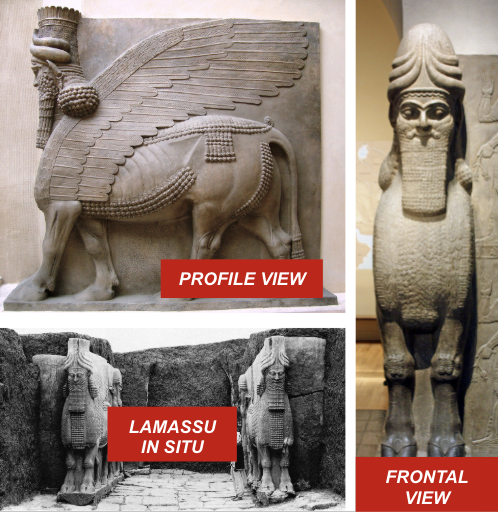
Image 25: LAMASSU
FORM:
Medium → Limestone
Relief statues
Carved out of monolithic stone (SUPER HUGE STONES) very heavy, big
Height → 13’9” TALL!
Location/Site → Stood at gates in between huge arches
FUNCTION:
Protected citadel gates
GUARDIAN FIGURES
GUARDIAN/GATEWAY FIGURES
Protected gates of citadel
Area where temple and royal palace were
Fearsome, powerful—maybe meant to represent king?
Guardian for exterior gate of city
CONTENT:
Lamassu → Winged bulls w/ heads of men
Crown → rosettes, double horns, ring of feathers
Delicate details for massive, powerful creature
Hair → Wavy hair below crown
Eyebrow → connected
Ears → bull
Earrings → decorative
Beard → ringlets on cheeks
Spirals as they go downward
Wings → decorative pattern up side of animal and across back
Inscriptions → Cuneiform—about the king and what happens if you wrong him
FRONTAL VIEW & PROFILE VIEW
Legs → 5 LEGS
2 from front, 4 on the side
Frontal View → Stationary, not moving
Profile View → animal is moving as well
Detail → Attention to detail of anatomy of Lamassu
Naturalistic & imagination of sculpture
CONTEXT:
Mesopotamia → cradle of civilization
Series of civilizations that conquered each other
Assyrians conquered most of Near East from 1000 – 500 BCE
Lamassu à Found at Palace of Sargon II at height of Assyrian civilization in 8th c. BCE
IRAQ
From modern day Khorsabad

Image 30: AUDIENCE HALL (APADANA) OF DARIUS & XERXES
FORM:
Medium → Mud brick with limestone facing
Height of Columns → ~79 ft. tall (24 meters)
Location/Site → Persepolis (capital of Persian Empire)
FUNCTION:
Commissioned → Darius & Xerxes (rulers of Persian Empire)
Function of Persepolis → Seat for spectacular receptions & festivals
Functional aspect → Economic & administrative center (capital of Empire)
Acted as a place of power-- supposed to impress & intimidate dignitaries from other countries
Apadana → Reception hall for king’s receptions; celebrated New Year’s festival
Procession of representatives of 23 subject nations
CONTENT:
Persepolis → Capital of the Persian Empire
Complex of palaces with giant audience hall (apadana)
Supposed to be enormous to impress & intimidate people from abroad
Apadana → Audience Hall
Reception hall for major events and festivities (New Year’s)
Reception hall for dignitaries from abroad
Originally 72 Columns → Lined throughout apadana with a wooden roof above
Base of Column → Bell-shaped (inverted lotus blossom)
Capital of Column → Bulls (double-headed), eagles, or lions (POWER ANIMALS)
Stairs → Lead up to the apadana
Relief Carvings → “Immortals” or the “King’s Guard”
Dignitaries processing forward offering gifts and bowing before king
CONTEXT:
Persepolis → Ceremonial capital of the Persian Empire (550-330 B.C.E.)
Meaning → “City of the Persians”
Ruins → All that remains of apadana are 14 columns, staircase, some capitals
Destruction → Alexander the Great of (Macedon) sacked, looted, and burned down Persepolis in 330 B.C.E.
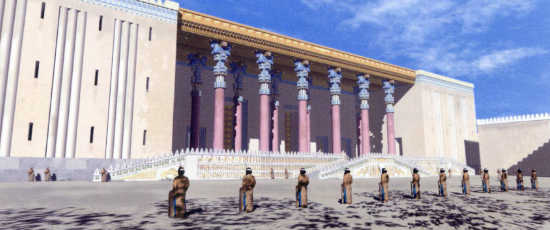
Image 30: AUDIENCE HALL (APADANA) OF DARIUS & XERXES
FORM:
Medium → Mud brick with limestone facing
Height of Columns → ~79 ft. tall (24 meters)
Location/Site → Persepolis (capital of Persian Empire)
FUNCTION:
Commissioned → Darius & Xerxes (rulers of Persian Empire)
Function of Persepolis → Seat for spectacular receptions & festivals
Functional aspect → Economic & administrative center (capital of Empire)
Acted as a place of power-- supposed to impress & intimidate dignitaries from other countries
Apadana → Reception hall for king’s receptions; celebrated New Year’s festival
Procession of representatives of 23 subject nations
CONTENT:
Persepolis → Capital of the Persian Empire
Complex of palaces with giant audience hall (apadana)
Supposed to be enormous to impress & intimidate people from abroad
Apadana → Audience Hall
Reception hall for major events and festivities (New Year’s)
Reception hall for dignitaries from abroad
Originally 72 Columns → Lined throughout apadana with a wooden roof above
Base of Column → Bell-shaped (inverted lotus blossom)
Capital of Column → Bulls (double-headed), eagles, or lions (POWER ANIMALS)
Stairs → Lead up to the apadana
Relief Carvings → “Immortals” or the “King’s Guard”
Dignitaries processing forward offering gifts and bowing before king
CONTEXT:
Persepolis → Ceremonial capital of the Persian Empire (550-330 B.C.E.)
Meaning → “City of the Persians”
Ruins → All that remains of apadana are 14 columns, staircase, some capitals
Destruction → Alexander the Great of (Macedon) sacked, looted, and burned down Persepolis in 330 B.C.E.

Image 13: KING NARMER’S PALETTE
FORM:
Medium → Slate
Relief sculpture
Bas-Relief
FUNCTION:
Utility Function:
Used to prepare makeup
Ceremonial Function:
However, this makeup palette is larger, more detailed, most likely commemorative or ceremonial
Burial ritual, potentially? It was buried underneath the temple floor as a votive or offering
CONTENT:
SO MUCH SYMBOLISM
Hierarchy of Scale → most important figures are large & centered on palette
Register → Horizontal band that tells a narrative
NARRATIVE → King Narmer uniting Upper & Lower Egypt
BOTH IMAGES:
Top Register → Hathor (a god) as a cow with a woman’s face
FIRST IMAGE:
Second Register → Narmer’s army marching forward towards dead bodies
Narmer → Largest figure with cobra crown (Red Crown) of lower Egypt
Bodies → Dead, beheaded bodies of enemies with legs between legs
Standard Bearers → Smaller figures, hoisting up standards before Narmer
Sandal Bearer → TINY DUDE behind Narmer, bringing forward his sandals
Third Register → Lionesses potentially with elongated, intertwining necks
Lionesses → Possibly symbolize unity?
Indentation → Their necks create an indented circle where historians believe is where the makeup would be placed
Bottom Register → Bull knocking down city fortress
Bull → Represents Narmer knocking down city walls
Hieroglyphics → explain & add meaning to everything-- WE HAVE WRITING!
SECOND IMAGE:
Hawk → Horus god of the sky
Rope (in Horus’ claw) → symbol of Lower Egypt
Papyrus plant (below Horus) → symbol of Lower Egypt
Narmer → symbol of strength
Bull’s tail → Power
Bowling pin-shaped Crown (White Crown) → Represents Narmer uniting Lower & Upper Egypt
Smiting Pose → Power
Servant (left of Narmer) → holding Narmer’s sandals
Smaller, less important
Bodies (lower register) → Defeated Egyptians at Narmer’s feet (lower register)
CONTEXT:
Predynastic → Upper & Lower Egypt were united over a period of time-- this work of art collapses this event in a short period of time
Makeup → Used as preparation for eye-makeup as protection from the sun
Similar to athletes putting black under their eyes-- reduces glare from the sun
Art Style → PREDYNASTIC EGYPT used the same art style (stiff & rigid) with similar forms of symbolism that we will see all throughout Egyptian art history
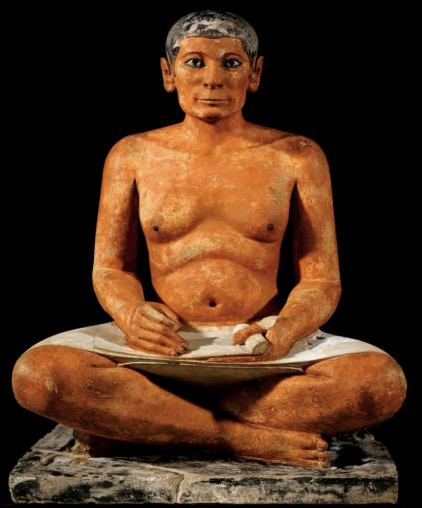
Image 15: SEATED SCRIBE
FORM:
Painted limestone
Still in color today
Amazingly lifelike, not a portrait
FUNCTION:
Created for tomb at Saqqara as provision for the ka
What is a ka in Old Kingdom Egypt? à Soul of human being or god
Maybe statue was meant for soul to inherit a physical form after death?
CONTENT:
More REALISTIC vs. IDEALISTIC
Sagging chest, a lil chub
Attentive expression– thin, angular face
Contrasts with ideal pharaoh
Holds papyrus scroll in lap, used to hold writing utensil in hand (gone)
CONTEXT:
Is he a pharaoh?
NOPE, just an average scribe-- not idealized
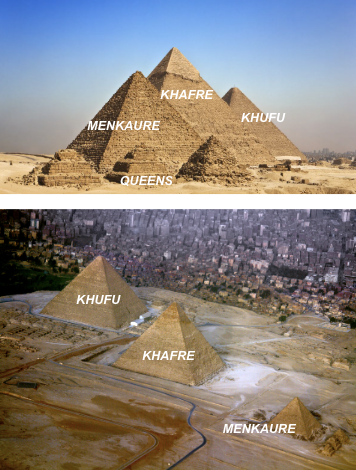
FORM:
Medium → Cut limestone
Originally faced with stone (white), but most is now lost
Height →
MASSIVE height-- unsurpassed for thousands of years
Shape → Reference to the sun and its rays-- thought of as the solidification of the sun’s rays from a single point
Sun’s Rays → Ramp for the pharaoh to climb to the sky when he reaches death
Shape → influenced by sacred stone relic– called benben (cute)
BEN-BEN → Ancient stone relic founded at the place of “initial creation”
Found at Heliopolis (center of sun god cult)
Axial Plan → Each side of pyramid points to compass point
FUNCTION:
Funerary/Burial → Giant monuments and tombs to dead pharaohs
Regeneration → Potentially where pharaohs could be regenerated (sacred shape)
CONTENT:
Three primary pyramids → Pharaohs Khufu, Khafre, and Menkaure
Each Pyramid → Had a mortuary complex
Mortuary Complex → Funerary Temple at its base, stone causeway (1 km in length) leading east from Giza to a valley temple
Interior → Minimal interior for the deceased
Smaller Pyramids & Small Tombs → Smaller cemeteries on east & west of Khufu’s Pyramid
This was an honor
Queen’s Tombs → Buried nearby primary pyramids
Pyramid → Considered where the pharaoh would be regenerated
Khafre’s Complex → Just east of Khafre’s pyramid sits the Sphinx
Khafre’s Sphinx → Represented as having the body of a cat and the head of the pharaoh
Symbolism:
Cats/felines → Important part of Egyptian life-- viewed cats as supernatural/powerful creatures
Pharaoh → By putting the head of the pharaoh on the body of a powerful creature, this combines two very powerful entities into one: the ruler & the feline
Sphinx → Powerful guardian figure
CONTEXT:
Pyramid → Considered where the pharaoh would be regenerated
Massive height-- unsurpassed for thousands of years
Pharaoh’s placement → Pharaohs buried IN pyramid– not UNDER
Sun → The sun was one of the most important parts of Egyptian everyday & religious life
Sun’s Rays → The pyramid’s shape acted as a ramp for the pharaoh to climb to the sky when he reaches death
Shape → influenced by sacred stone relic– called ben-ben (cute, we love that)
BEN-BEN → Ancient stone relic founded at the place of “initial creation”
Found at Heliopolis (center of sun god cult)
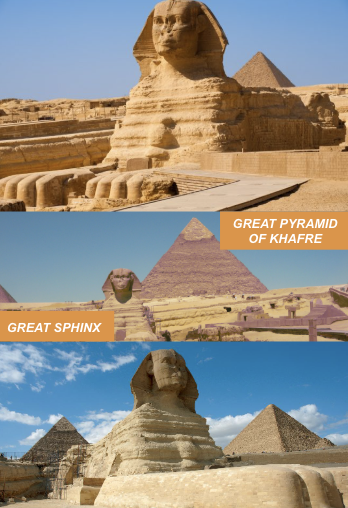
FORM:
Medium → Cut limestone
Originally faced with stone (white), but most is now lost
Height →
MASSIVE height-- unsurpassed for thousands of years
Shape → Reference to the sun and its rays-- thought of as the solidification of the sun’s rays from a single point
Sun’s Rays → Ramp for the pharaoh to climb to the sky when he reaches death
Shape → influenced by sacred stone relic– called benben (cute)
BEN-BEN → Ancient stone relic founded at the place of “initial creation”
Found at Heliopolis (center of sun god cult)
Axial Plan → Each side of pyramid points to compass point
FUNCTION:
Funerary/Burial → Giant monuments and tombs to dead pharaohs
Regeneration → Potentially where pharaohs could be regenerated (sacred shape)
CONTENT:
Three primary pyramids → Pharaohs Khufu, Khafre, and Menkaure
Each Pyramid → Had a mortuary complex
Mortuary Complex → Funerary Temple at its base, stone causeway (1 km in length) leading east from Giza to a valley temple
Interior → Minimal interior for the deceased
Smaller Pyramids & Small Tombs → Smaller cemeteries on east & west of Khufu’s Pyramid
This was an honor
Queen’s Tombs → Buried nearby primary pyramids
Pyramid → Considered where the pharaoh would be regenerated
Khafre’s Complex → Just east of Khafre’s pyramid sits the Sphinx
Khafre’s Sphinx → Represented as having the body of a cat and the head of the pharaoh
Symbolism:
Cats/felines → Important part of Egyptian life-- viewed cats as supernatural/powerful creatures
Pharaoh → By putting the head of the pharaoh on the body of a powerful creature, this combines two very powerful entities into one: the ruler & the feline
Sphinx → Powerful guardian figure
CONTEXT:
Pyramid → Considered where the pharaoh would be regenerated
Massive height-- unsurpassed for thousands of years
Pharaoh’s placement → Pharaohs buried IN pyramid– not UNDER
Sun → The sun was one of the most important parts of Egyptian everyday & religious life
Sun’s Rays → The pyramid’s shape acted as a ramp for the pharaoh to climb to the sky when he reaches death
Shape → influenced by sacred stone relic– called ben-ben (cute, we love that)
BEN-BEN → Ancient stone relic founded at the place of “initial creation”
Found at Heliopolis (center of sun god cult)
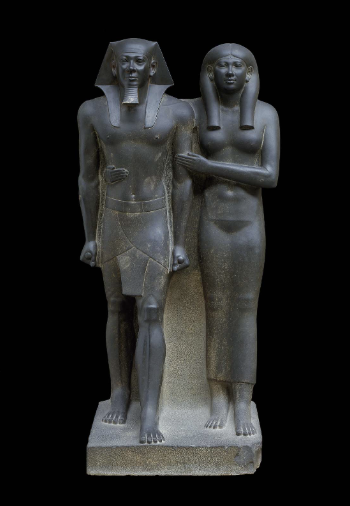
Image 18: MENKAURE AND HIS QUEEN
FORM:
Medium → Greywacke-- a dark coarse-grained sandstone containing more than 15 percent clay.
Smooth, finished surface
Attached to block stone– what’s this called? BAS RELIEF
FUNCTION:
Honor/ritual/burial– Found in Giza pyramid complex in Menkaure’s Valley Temple in Great Pyramids of Giza
CONTENT:
Menkaura & his Queen (we think his wife)
Queen → presenting her husband to gods? Since it’s in death?
Or possibly just simple & affectionate gesture? Or PROTECTIVE?
Idealized bodies– did they look like this when they died?
Because figure of royalty, wanted to make them look as good as possible
Wife’s ankle-length gown, tight, conformed to body (she sexy!)
SAME HEIGHT!!! WHAT DOES THIS MEAN? Equality! Yay women!!
DRESS →
Typical Pharaoh headdress (iconic striped nemes headdress)
Artificial royal beard
Ritual cloth rolls in his fists
CONTEXT:
QUESTION OF WHO THE ROYAL FEMALE IS– either his wife or even maybe……queen mother?
Just one of many statues found in Valley Temple of Menkaure
Many triad statues– depicting pharaoh flanked by 2 goddesses:
Hathor (“house of Horus”) à Representative of pharaoh’s wife; fierce protector
“Nome” goddess à representative of a region, place, etc.
Horus was also worshipped in these tombs à represented by living king
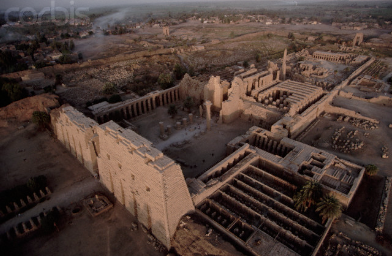
Image 20: TEMPLE OF AMUN-RE AND HYPOSTYLE HALL
FORM:
Medium (Temple) → Mudbrick
Medium (Columns) → Cut sandstone
134 columns total-- 12 taller columns down the middle of the hall
Painted → Most of the temple would’ve been painted bright colors-- not really seen today because of exposure
Some paint still remains today on the higher portions of the columns & ceiling today
FUNCTION:
Religious center of the god Amun-Re in Thebes
Karnak wasn’t just one temple dedicated to 1 god– held main precinct to the god Amun-Re– also precincts of the gods Mut & Montu
CONTENT:
TEMPLE:
Pylon → monumental gateway to an Egyptian temple marked by 2 flat, sloping walls; In between walls = smaller entrance; protected the sanctuary
Behind pylon → central courtyard (peristyle), greeted worshippers
Peristyle → row of pillars/columns enclosing a courtyard
Past courtyard → hypostyle hall with 134 massive sandstone columns
God was housed in sacred area just beyond– surrounded by forest of columns called hypostyle hall
HYPOSTYLE HALL:
Hypostyle → hall in an Egyptian temple that has roof supported by dense thicket of columns
Clerestory → roof that rises above lower roofs with window space beneath
Columns → 134 massive sandstone columns total
Taller Columns → 12 taller columns that run down the middle of the hall-- up to 69 ft. tall
Capitals of Taller Columns → Papyrus/flower capitals
Shorter Columns → 122 shorter columns that support the rest of the roofing
Capitals of the Shorter Columns → Bud capitals (not yet bloomed)
Center of hall → taller than spaces on either side; allowed for clerestory lighting (first evidence for clerestory lighting)
Farther you proceed, the more restricted access became
SYMBOLISM:
Temple → symbolic of “creation of the world”/mound of creation
Pylons → Horizon
Rising floors until reaching the sanctuary of the god → impression of a rising mound, like that during creation
Temple roof → Sky (decorated with stars & birds)
Columns → designed w/ lotus, papyrus, palm plants → Marsh-like environment of creation
CONTEXT:
Time period → First developed during Middle Kingdom (2055-1650 B.C.E.)
Size → Originally modest in scale
But Thebes became more important and pharaohs began to leave their mark here
City of Karnak (location) → Karnak became known as “The Most Select of Places”
Characteristics of New Kingdom (1550-1070 B.C.E.):
Free-standing monuments
Religious hierarchy → The farther you go into the temple, the more restricted access becomes (you must be “this religious” to enter)
Thebes & religion → Principal religious center of the god Amun-Re in Thebes
One of the largest religious complexes in the world
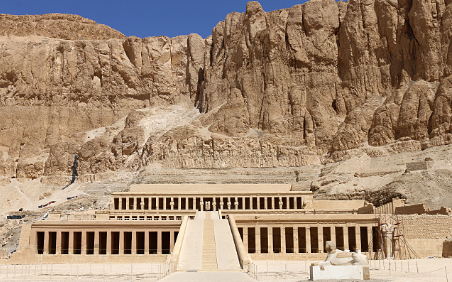
Image 21: HATSHEPSUT MORTUARY TEMPLE & HATSHEPSUT WITH OFFERING JARS STATUE
FORM:
TEMPLE:
Medium → sandstone
Carved out of cliff while also built up with stone blocks
Built directly against vast cliff-face
Dramatic environment
Organic quality– contrastive of strict order
Stability, order against such a natural landscape
Coordinated with natural setting
Layout → 3 colonnaded terraces and 2 ramps
Horizontals & verticals of terraces repeat patterns of cliffs
Light vs. dark
STATUE:
Medium → Red granite
Free-standing
No negative space between arms & torso, between legs
FUNCTION:
TEMPLE:
Originally meant to keep Queen Hatshepsut after death
STATUE:
part of ritual in honor of Amun-Re (sun god)
Statue of Amun brought before sculpture in procession
CONTENT:
TEMPLE:
Made up of 3 terraces & 2 ramps
Terraces → Would have originally held exotic plants
Built directly against vast cliff-face
Dramatic environment
Organic quality– contrastive of strict order
Stability, order against such a natural landscape
Hatshepsut Sphinx → Representations of Hatshepsut as a sphinx in lower courtyard of temple
STATUE:
One of 200 around entire complex
One of 10 kneeling w/ offering jars
Female vs. Male Characteristics → Why does this female pharaoh look like a man?
Male attributions → Classic pharaoh headdress with cobra crown (Upper Egypt crown)
Kilt
False beard
Broad shoulders
Femininity → Still has some slender proportions
Slight breasts
Identifying words (hieroglyphs) → Identify her as female
Sculpture on knees → who would be the only being that Pharaoh would kneel to? A god
Offering Jars → Offered as sacrifice to god (Amun-Re)-- we believe they could’ve been plants?
CONTEXT:
Time Period → New Kingdom
WOMEN’S HISTORY → First time achievements of a woman are celebrated in art history
Hatshepsut → A powerful woman who assumes role of authority as a king/pharaoh
Importance of ART to Hatshepsut → Created mythology of her divine birth
Commissioned art & temples during her rule
Period of instability → beginning of New Kingdom that Hatshepsut ushered in began peace
Destroying evidence of Hatshepsut → Her co-Ruler tried to destroy all evidence of female Hatshepsut’s power
Fragments discovered in early 20th c.
Kneeling Pharaoh → Why was pharaoh on her knees? Who would she be kneeling to?
Sculptures of god → literal embodiment of the god
Temples of god → literal house of god
Annual Ceremony for Amun-Re → Ceremony where Egyptians took statue of Amun (sun god) from Temple of Amun-Re to spend night in Mortuary temple of Hatshepsut
Annual celebration → Once a year, primary sculpture of Amun carried across Nile River on ceremonial barque (shrine shaped as boat) traveling west across Nile from land of living towards land of dead, carried up causeway towards temple to his primary shrine of Amun in Mortuary Temple and then returned across river– makes sense to have sculpture of Hatshepsut on her knees with offerings
Hatshepsut’s Body → Her body was interred elsewhere

Image 21: HATSHEPSUT MORTUARY TEMPLE & HATSHEPSUT WITH OFFERING JARS STATUE
FORM:
TEMPLE:
Medium → sandstone
Carved out of cliff while also built up with stone blocks
Built directly against vast cliff-face
Dramatic environment
Organic quality– contrastive of strict order
Stability, order against such a natural landscape
Coordinated with natural setting
Layout → 3 colonnaded terraces and 2 ramps
Horizontals & verticals of terraces repeat patterns of cliffs
Light vs. dark
STATUE:
Medium → Red granite
Free-standing
No negative space between arms & torso, between legs
FUNCTION:
TEMPLE:
Originally meant to keep Queen Hatshepsut after death
STATUE:
part of ritual in honor of Amun-Re (sun god)
Statue of Amun brought before sculpture in procession
CONTENT:
TEMPLE:
Made up of 3 terraces & 2 ramps
Terraces → Would have originally held exotic plants
Built directly against vast cliff-face
Dramatic environment
Organic quality– contrastive of strict order
Stability, order against such a natural landscape
Hatshepsut Sphinx → Representations of Hatshepsut as a sphinx in lower courtyard of temple
STATUE:
One of 200 around entire complex
One of 10 kneeling w/ offering jars
Female vs. Male Characteristics → Why does this female pharaoh look like a man?
Male attributions → Classic pharaoh headdress with cobra crown (Upper Egypt crown)
Kilt
False beard
Broad shoulders
Femininity → Still has some slender proportions
Slight breasts
Identifying words (hieroglyphs) → Identify her as female
Sculpture on knees → who would be the only being that Pharaoh would kneel to? A god
Offering Jars → Offered as sacrifice to god (Amun-Re)-- we believe they could’ve been plants?
CONTEXT:
Time Period → New Kingdom
WOMEN’S HISTORY → First time achievements of a woman are celebrated in art history
Hatshepsut → A powerful woman who assumes role of authority as a king/pharaoh
Importance of ART to Hatshepsut → Created mythology of her divine birth
Commissioned art & temples during her rule
Period of instability → beginning of New Kingdom that Hatshepsut ushered in began peace
Destroying evidence of Hatshepsut → Her co-Ruler tried to destroy all evidence of female Hatshepsut’s power
Fragments discovered in early 20th c.
Kneeling Pharaoh → Why was pharaoh on her knees? Who would she be kneeling to?
Sculptures of god → literal embodiment of the god
Temples of god → literal house of god
Annual Ceremony for Amun-Re → Ceremony where Egyptians took statue of Amun (sun god) from Temple of Amun-Re to spend night in Mortuary temple of Hatshepsut
Annual celebration → Once a year, primary sculpture of Amun carried across Nile River on ceremonial barque (shrine shaped as boat) traveling west across Nile from land of living towards land of dead, carried up causeway towards temple to his primary shrine of Amun in Mortuary Temple and then returned across river– makes sense to have sculpture of Hatshepsut on her knees with offering
Hatshepsut’s Body → Her body was interred elsewhere

Image 22: AKHENATON, NEFERTITI, & THREE DAUGHTERS
FORM:
Medium → Limestone
Height → 1’ ¼”
Carved into the limestone
Sunken relief carving
Style of Amarna Period:
Style changes drastically—Egyptian art has been known to be very consistent until the Amarna period
Differences: Elongated skulls; swollen, low-hanging bellies; slack jaws; smoother, curved surfaces; thin arms; heavy-lidded eyes
Similarities: Composite view of bodies, profile view of face, frontal view eye
FUNCTION:
Domestic & religious → Panel is from an altar in a home
Setting of Domesticity is new in Egyptian art
Meant to be placed in a very private, domestic environment
CONTENT:
FIGURES:
Akhenaton (left) → Holding his eldest daughter, about to kiss her on her head
Holding her underneath her thighs
King/Pharaoh → Depicted with some royal symbols-- work does not emphasize his position as ruler
Throne → Much simpler
Eldest Daughter (in Akhenaton’s arms) → Pointing back at Nefertiti (mom)
Second eldest daughter (on Nefertiti’s lap) → Pointing at Akhenaton
Youngest daughter (on Nefertiti’s shoulder) → Playing with Nefertiti’s earring
Nefertiti → About the same height as Akhenaton
Queen/Wife/Mother → Nefertiti, Akhenaton’s wife, is depicted as just as powerful as Akhenaton (height, dress, etc.)
Throne → Symbolic and representing both Lower & Upper Egypt
Represents that she is equally as important to helping rule these two parts of Egypt
Sun (Aton) → Sun disk with rays of light (and hands at the end of rays) emanating from the sun disk
Aton → Sun disk god that Akhenaton installed as the primary god of Egyptian religion during Amarna period
Anatomy → Swollen bellies
Elongated skulls
Thin arms
Long, thin necks
SYMBOLISM:
Sun disk → God/Aton
Aton in Amarna Period → Sun disk god that Akhenaton installed as the primary god of Egyptian religion during Amarna period
Cobra in sun → Supreme deity; ONLY deity
Such contrast to pantheon of gods that traditional Egypt has depended on
Rays of light → Hands at the end of rays;
Ankhs → at end of rays of life pointing at Akhenaton & Nefertiti
Egyptian sign of life (pointing at their noses—breath of life)
Nefertiti’s throne → Upper & Lower Egypt symbols combined; symbolizes her importance as queen and how they would rule Egypt together
CONTEXT:
Akhenaton changes state religion from Amun to Aton
From pantheon of gods to “one true god”
Changes his name to Akhenaton to symbolize this (“Aton is pleased”)
Akhentaton & Nefertiti (wife) → Only representatives of Aton on earth
Religious priests → Egypt priesthood was pissed because they had no connection with new religion or god

Image 23: TUTANKHAMUN’S TOMB (INNERMOST COFFIN + MASK)
FORM:
COFFIN:
Gold coffin 6’7” long
Inside → Different, smaller coffins residing within another to protect the pharaoh’s body within the innermost coffin
MASK:
Golden with smoothly idealized features of boy-king
Constructed of 2 sheets of gold—hammered together and weighs 22.5 lbs
FUNCTION:
Funerary → Pharaoh Tutankhamen’s body was interred in the coffin and mask
CONTENT:
COFFIN:
Sarcophagus (box-like stone container) → held 3 COFFINS to hold body of the king
Outer 2 Coffins → made of wood, covered in gold with semiprecious stones (lapis lazuli & turquoise)
Inner Coffin → SOLID GOLD! Originally covered in anointing liquid for burial rituals
Pharaoh = GOD
Gods → Believed to have skin of Gold, bones of silver, and hair of lapis lazuli
SYMBOLISM:
Golden Coffin → king is shown in divine form of afterlife
Crook & Flail → King’s right to rule
Goddesses represented within coffins:
Vulture → Nekhbet
Cobra → Wadjet
Isis
Nephthys
MASK:
Rests on the shoulders in the innermost gold coffin
Striped nemes headdress
Goddesses Nekhbet & Wadjet protecting his brow
False beard → IMAGE OF GOD
Broad collar → ends in falcon heads
Back of mask → covered with Spell 151b from Book of the Dead
Egyptians used this as road map for afterlife
Spell protects Tut’s limbs as he moves into the underworld
CONTEXT:
Tutankhamen → King Tut became king at 9 years old
Unhealthy → Believed to have been a sickly boy and young man due to the incestuous practices of Egyptian royalty
Died at young age → Died at only 18 years old as a result of illness (“keeping it in the family”)
Death in Egyptian beliefs → Believed to reach judgment to either move onto the afterlife or cease to exist (refer to Last Judgment of Hunefer)
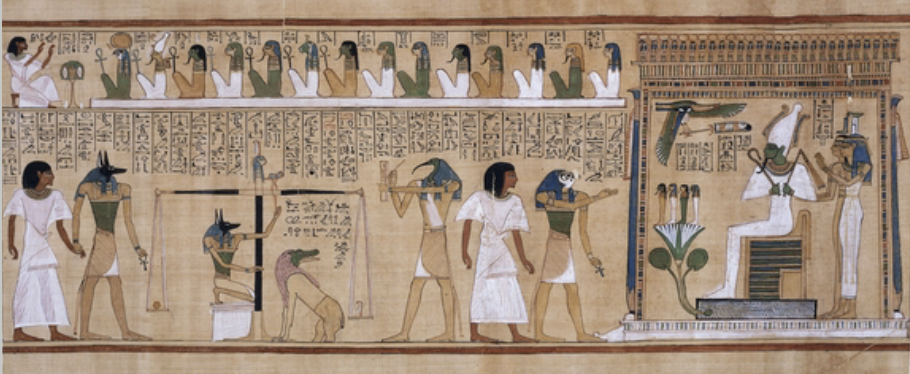
Image 24: LAST JUDGMENT OF HU-NEFER
FORM:
Medium → Painted papyrus scroll
Reed that rows in Nile delta made into paper-like surface
Important way to write until medieval times
FUNCTION:
Book of the Dead → Spells, prayers, incantations dead needed in afterlife
Instructions for the afterlife
Burial ritual—meant to help the dead in the afterlife
CONTENT:
Spells, prayers, incantations
Instruction for the afterlife
Registers:
Top band → Hunefer crouched, telling various gods of his great life and why he’s earned a place in afterlife
Main band → Scene of judgment
Representations of man who died (white robe)
Figures:
Hunefer → All figures in white robe
Anubis → god with jackal head/god of death—leading Hunefer by the hand
Ankh in left hand (eternal life) → Hunefer’s afterlife
Anubis crouching → Adjusting scale
Left → Hunefer’s Heart
Right → Feather of Ma’at
Ma’at → Deity associated with divine order + ethical life
Feather → lower, heavier, shows he had ethical life—Hunefer will make it to afterlife
Ammit → Monster that eats you if you did not life ethical life
Head of crocodile, body of lion, bottom of hippo
Would devour heart if he lived an unethical life
Scale → Test to pass into afterlife
Thoth → Head of ibis (bird)
Recording proceedings of Hunefer’s judgment
Arm stretched out, upright, trustworthy
Osiris → White garments, greenish skin
Supreme god
Symbols of royalty all around—enclosure, crook & flail, throne
Lotus → eternal life
Horus’s Children → on top of lotus; cardinal points
Responsible for carrying internal organs placed in Canopic jars
Responsible to preserving the dead
Horus → Eye/falcon
Talons instead of hands à carry ostrich feather
Ostrich feather → eternal life
Horus → Falcon head – son of Osiris—introducing him to Osiris
Also holding Ankh
Isis → Osiris life
Nephthys → Isis’s sister
Guardian of afterlife and sister of Anubis
White Platform → natural salts deposited in Nile to dry out mummies
CONTEXT:
Old Kingdom:
Pyramid texts
Middle Kingdom:
Coffin texts
New Kingdom:
Papyrus “Books of the Dead”
Sometimes written on shrouds dead were buried in
Made mostly for king—then royal family—then for people of high rank
Found in tomb of Hunefer—scribe = priestly status = higher status
Could read, write
Afterlife → there is only 1; if you don’t make it, you no longer exist in any capacity
Integration of visual arts & writing in one place (important in Egyptian art)